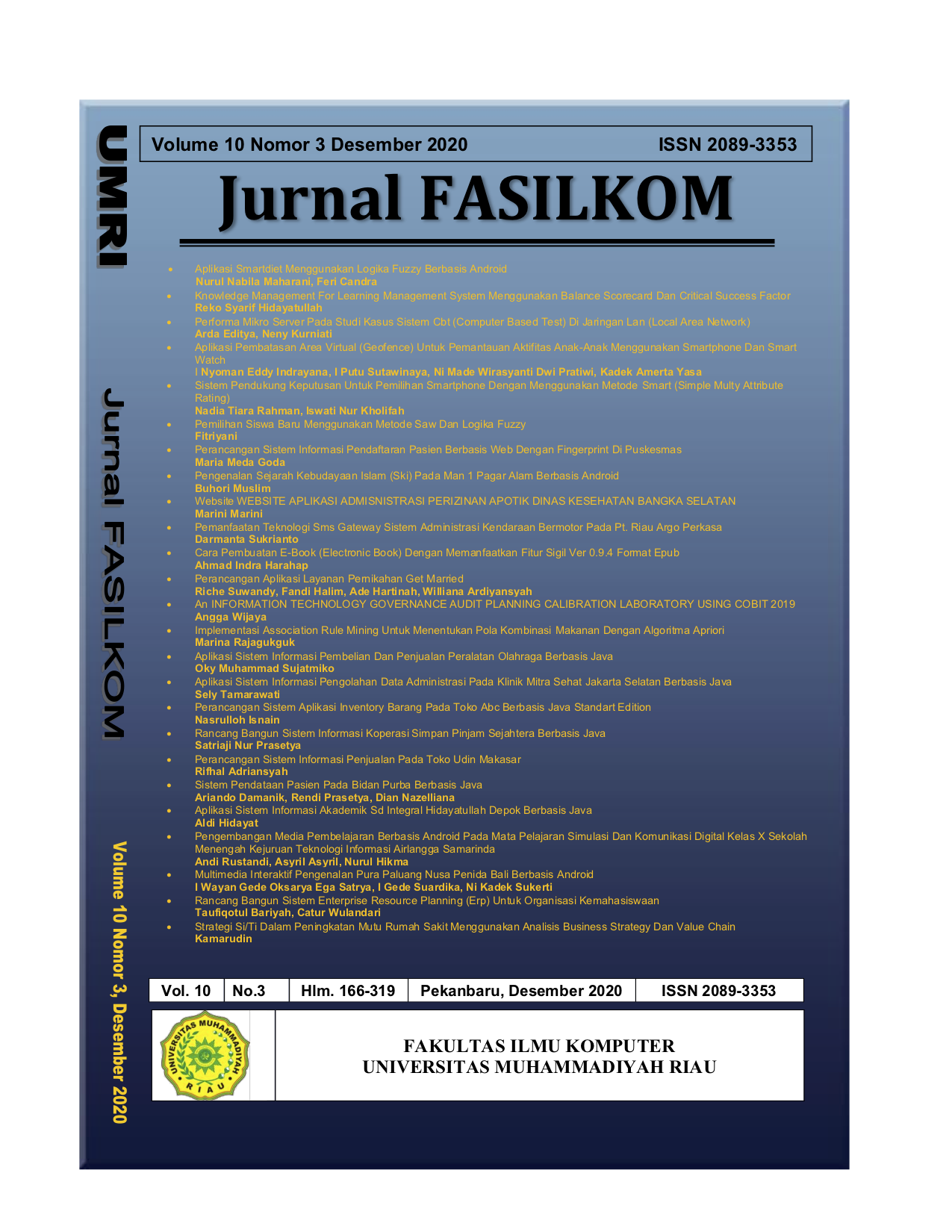APLIKASI PEMBATASAN AREA VIRTUAL (GEOFENCE) UNTUK PEMANTAUAN AKTIFITAS ANAK-ANAK MENGGUNAKAN SMARTPHONE DAN SMART WATCH
DOI:
 https://doi.org/10.37859/jf.v10i3.2325
https://doi.org/10.37859/jf.v10i3.2325
Abstract
Pemantauan pergerakan anak-anak sangat dibutuhkan oleh orang tua untuk menghindari hal hal yang tidak diinginkan. Teknologi GPS dapat dimanfaatkan untuk melakukan pengawasan melalui smartphone yang dikombinasikan dengan pembatasan area secara virtual(geofence) untuk meningkatkan pengawasan pada saat orang tua tidak berada di dekat anak-anaknya. Pembatasan area secara virtual ini akan membantu memberikan sinyal otomatis kepada orang tua pada saat anak-anak melakukan pergerakan diluar area yang diijinkan. Aplikasi ini dibangun menggunakan metode Unified System Development Process(USDP) dan menerapkan rumus Haversine untuk menghitung jarak antara 2 posisi di bumi. Rumus Haversine ini digunakan dalam proses mendeteksi apakah suatu objek berada pada area yang diijinkan ataukah tidak. Pembatasan area virtual dalam aplikasi ini menggunakan bentuk lingkaran. Aplikasi ini membutuhkan 2 aktor yaitu aktor orang tua yang bertindak sebagai pemantau dan aktor anak yang bertindak sebagai objek yang dipantau. Orang tua menggunakan smartphone android untuk melihat pergerakan anak melalui google map dan sekaligus untuk mengatur geofence si anak sehingga lebih mudah melakukan pemantauan. Sedangkan si anak menggunakan smartwatch untuk mengirimkan koordinat latitude dan longitude posisinya ke server database firebase. Perangkat smartwatch yang digunakan si anak ini, lebih ringan dan lebih praktis karena dipakai di tangan
Downloads
References
[2] Beny, J. Budiman, and A. Nugroho, “Implementasi Geofencing Pada Aplikasi Layanan Pemantau Anak Berbasis Lokasi,” in 2nd Seminar Nasional IPTEK Terapan (SENIT), 2017, pp. 63–66.
[3] I. N. E. Indrayana, P. Sutawinaya, N. M. Wirasyanti, I. K. Swardika, and P. W. Sunu, “Design of Children Monitoring Application for Outdoor Activities Using a Smart Watch,” in Journal of Physics: Conference Series, 2020, vol. 1569, p. 32093, doi: 10.1088/1742-6596/1569/3/032093.
[4] I. K. G. Sudiartha, I. N. E. Indrayana, I. W. Suasnawa, and P. I. Ciptayani, “Design And Implementation of Group Tourist Monitoring Application With Realtime Database Firebase,” in International Conference on Science and Technology (ICST 2018), Dec. 2018, pp. 1078–1083, doi: https://doi.org/10.2991/icst-18.2018.217.
[5] I. K. G. Sudiartha, I. N. E. Indrayana, I. W. Suasnawa, S. A. Asri, and P. W. Sunu, “Data Structure Comparison between MySql Relational Database and Firebase Database NoSql on Mobile Based Tourist Tracking Application,” J. Phys. Conf. Ser., vol. 1569, no. 3, 2020, doi: 10.1088/1742-6596/1569/3/032092.
[6] S. Rahate and M. Shaikh, “Geo-fencing Infrastructure: Location Based Service,” Int. Res. J. Eng. Technol., vol. 03, no. 11, pp. 1095–1098, 2016.
[7] J. M. Bohli, D. Dobre, G. O. Karame, and W. Li, “PrivLoc: Preventing location tracking in Geofencing services,” in International Conference on Trust and Trustworthy Computing, 2014, vol. 8564, no. April, pp. 143–160, doi: 10.1007/978-3-319-08593-7_10.
[8] N. S. Priyanka Mohite, Adarsh Nair, “Geofencing and Locatoin Based Reminder Services,” Int. J. Adv. Eng. Res. Dev., vol. 3, no. 10, pp. 137–141, 2016, doi: 10.21090/ijaerd.031025.
[9] B. Karthikeyan, R. Charan, L. Ganapathy, J. Gobuviknesh, and P. Afsal, “Self-Care Application Using Android Google Maps and Geofence,” Int. J. Comput. Sci. Trends Technol., vol. 5, no. 2, pp. 28–32, 2017.
[10] D. Sunehra, P. L. Priya, and A. Bano, “Children Location Monitoring on Google Maps Using GPS and GSM Technologies,” in 2016 IEEE 6th International Conference on Advanced Computing (IACC), Feb. 2016, pp. 711–715, doi: 10.1109/IACC.2016.137.
[11] A. Gupta and V. Harit, “Child Safety & Tracking Management System by Using GPS, Geo-Fencing & Android Application: An Analysis,” in 2016 Second International Conference on Computational Intelligence & Communication Technology (CICT), Feb. 2016, pp. 683–686, doi: 10.1109/CICT.2016.141.
[12] Z. Wang, “The study of smart phone development based on UML,” 2011 Int. Conf. Comput. Sci. Serv. Syst. CSSS 2011 - Proc., pp. 2791–2794, 2011, doi: 10.1109/CSSS.2011.5973939.
[13] P. Dauni, M. D. Firdaus, R. Asfariani, M. I. N. Saputra, A. A. Hidayat, and W. B. Zulfikar, “Implementation of Haversine formula for school location tracking,” J. Phys. Conf. Ser., vol. 1402, no. 7, 2019, doi: 10.1088/1742-6596/1402/7/077028.
[14] Ganesh and V. Kumar, “Indoor Wireless Localization using Haversine Formula,” Iarjset, vol. 2, no. 7, pp. 59–63, 2015, doi: 10.17148/IARJSET.2015.2713.
[15] S. Hartanto, M. Furqan, A. Putera, U. Siahaan, and W. Fitriani, “Haversine Method in Looking for the Nearest Masjid,” Int. J. Recent Trends Eng. Res., vol. 3, no. 8, pp. 187–195, 2017, doi: 10.23883/ijrter.2017.3402.pd61h.
[16] M. Alsaqer, B. Hilton, T. Horan, and O. Aboulola, “Performance Assessment of Geo-triggering in Small Geo-fences: Accuracy, Reliability, and Battery Drain in Different Tracking Profiles and Trigger Directions,” Procedia Eng., vol. 107, pp. 337–348, 2015, doi: 10.1016/j.proeng.2015.06.090.
Downloads
Published
Issue
Section
License
Copyright Notice
An author who publishes in the Jurnal FASILKOM (teknologi inFormASi dan ILmu KOMputer) agrees to the following terms:
- Author retains the copyright and grants the journal the right of first publication of the work simultaneously licensed under the Creative Commons Attribution-ShareAlike 4.0 License that allows others to share the work with an acknowledgement of the work's authorship and initial publication in this journal
- Author is able to enter into separate, additional contractual arrangements for the non-exclusive distribution of the journal's published version of the work (e.g., post it to an institutional repository or publish it in a book) with the acknowledgement of its initial publication in this journal.
- Author is permitted and encouraged to post his/her work online (e.g., in institutional repositories or on their website) prior to and during the submission process, as it can lead to productive exchanges, as well as earlier and greater citation of the published work (See The Effect of Open Access).
Read more about the Creative Commons Attribution-ShareAlike 4.0 Licence here: https://creativecommons.org/licenses/by-sa/4.0/.












_(1).png)





